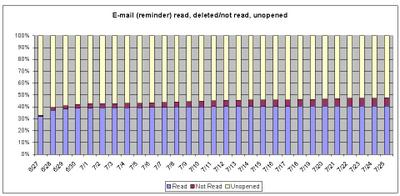I've finished comparing the read receipts from two e-mail announcements. The first went out two weeks in advance, letting people know that a new online tool was going to launch on June 27. The second went out on June 27, telling people it was up and ready to use. Here's the time chart for the second message -- it looks very much like the first one.

Again, 60 percent of the e-mails were never opened; that's the bad news. The good news is that people who open the e-mails open them fast. Nearly 80 percent were opened on the first day; more than 90 percent by the second day; and more than 95 percent by the third day. Leaving aside the question of whether they read or absorbed the message, they did open it.
Was the reminder worth it? I think so. Here's a breakdown that shows how many people opened each message, with the percent of the total audience (1910 addressees):
- Opened the first but not the second - 223 (12%)
- Opened the second but not the first - 240 (13%)
- Opened both - 551 (29%)
- Total opened - 1,014 (53%)
The reminder e-mail accounted for 24 percent of the total opened e-mails.
The data shows 5 percent of the recipients deleted both messages without opening them. It may be interesting to know if they are doing that soon after the mailing -- that would indicate they just aren't taking our calls. But it's just 5 percent and there are bigger fish to fry.
I've still not absorbed the full impact of this data -- half of these e-mails are never opened. There are a couple of things that appear evident:
- It looks like this particular corporate mailbox has a lousy brand. Readers don't expect value from its messages.
- E-mail is fast, cheap and easy but it's not reaching a big segment of the population. We need to find another powerful vehicle that will appeal to the e-mail averse.
The basic data here -- e-mail never opened -- is ridiculously easy to gather. Anyone else going to try it?
I'm going to do similar experiments on mail from senior leaders to see how that changes the rate of mail opened.

